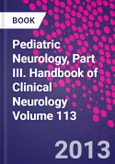The child is neither an adult miniature nor an immature human being: at each age, it expresses specific abilities that optimize adaptation to its environment and development of new acquisitions. Diseases in children cover all specialties encountered in adulthood, and neurology involves a particularly large area, ranging from the brain to the striated muscle, the generation and functioning of which require half the genes of the whole genome and a majority of mitochondrial ones. Human being nervous system is sensitive to prenatal aggression, is particularly immature at birth and development may be affected by a whole range of age-dependent disorders distinct from those that occur in adults. Even diseases more often encountered in adulthood than childhood may have specific expression in the developing nervous system. The course of chronic neurological diseases beginning before adolescence remains distinct from that of adult pathology - not only from the cognitive but also motor perspective, right into adulthood, and a whole area is developing for adult neurologists to care for these children with persisting neurological diseases when they become adults.
Just as pediatric neurology evolved as an identified specialty as the volume and complexity of data became too much for the general pediatician or the adult neurologist to master, the discipline has now continued to evolve into so many subspecialties, such as epilepsy, neuromuscular disease, stroke, malformations, neonatal neurology, metabolic diseases, etc., that the general pediatric neurologist no longer can reasonably possess in-depth expertise in all areas, particularly in dealing with complex cases. Subspecialty expertise thus is provided to some trainees through fellowship programmes following a general pediatric neurology residency and many of these fellowships include training in research.
Since the infectious context, the genetic background and medical practice vary throughout the world, this diversity needs to be represented in a pediatric neurology textbook. Taken together, and although brain malformations (H. Sarnat & P. Curatolo, 2007) and oncology (W. Grisold & R. Soffietti) are covered in detail in other volumes of the same series and therefore only briefly addressed here, these considerations justify the number of volumes, and the number of authors who contributed from all over the world. Experts in the different subspecialties also contributed to design the general framework and contents of the book. Special emphasis is given to the developmental aspect, and normal development is reminded whenever needed - brain, muscle and the immune system. The course of chronic diseases into adulthood and ethical issues specific to the developing nervous system are also addressed.
Please Note: This is an On Demand product, delivery may take up to 11 working days after payment has been received.
Table of Contents
SECTION 14 Neuromuscular DisordersDiagnostic work-up for neuromuscular diseases; Main steps of the skeletal muscle development in human: Morphological analysis and ultrastructural characteristics of developing human muscle; Arthrogryposis and fetal hypomobility syndrome; Congenital myopathies; Myofibrillar myopathies; Progressive muscular dystrophies; Emery-Dreifuss muscular dystrophy, laminopathies and other nuclear envelopathies; Congenital muscular dystrophies; Congenital and infantile myotonic dystrophy; Spinal muscular atrophies; Hereditary motor-sensory, motor and sensory neuropathies in childhood; Muscle channelopathies and related diseases; Metabolic neuropathies and myopathies; Juvenile dermatomyositis; Autoimmune myasthenia gravis; Congenital myasthenic syndromes; Neuromuscular complications of intensive care; Respiratory care in neuromuscular disorders; Medical and psychosocial considerations in rehabilitation care of childhood neuromuscular diseases; Innovating therapies for muscle diseases
SECTION 15 Cranial nerves and brainstem dysfunction
Eye movement control and its disorders; The optic nerve and visual pathways; Hearing loss and deafness in the paediatric population: causes, diagnosis and rehabilitation; Congenital feeding and swallowing disorders
SECTION 16 Inborn errors of metabolism and storage diseases
Diagnostic work-up in acute conditions of inborn errors of metabolism and storage diseases; Metabolic diagnostic work-up in chronic conditions; Inborn errors of brain myelin formation; Peroxisomal disorders; Lysosomal leukodystrophies: Krabbe disease and metachromatic leukodystrophy; Leukodystrophies with astrocytic dysfunction; Aicardi-Goutières syndrome; Disorders of nucleotide excision-repair; Respiratory chain deficiencies; Disorders of pyruvate metabolism; Disorders of fatty acid oxidation; Glucide metabolism disorders (excluding glycogen myopathies); Lysosomal diseases: biochemical pathways and investigations; Neuronal ceroid lipofuscinoses; Gangliosidoses; Gaucher disease; Niemann-Pick diseases; Mucopolysaccharidoses and mucolipidoses; Progressive myoclonus epilepsy; Congenital disorders of glycosylation; Inborn errors of copper metabolism; Defects in amino acid catabolism and the urea cycle; Amino acid synthesis deficiencies; Epileptic encephalopathy with suppression-bursts and non-ketotic hyperglycinemia; Vitamin-responsive disorders: cobalamin, folate, biotin, vitamins B1 and E; Pyridoxine and pyridoxalphosphate dependent epilepsies; Monoamine neurotransmitter deficiencies; Metabolic disorders of purine metabolism affecting the nervous system; Creatine deficiency syndromes; Cholesterol metabolism deficiency; Enzyme replacement therapy and substrate reduction therapy in lysosomal storage disorders with neurological expression; Gene therapy for disorders of the central nervous systems
SECTION 17 Heredodegenerative disorders
Progressive cerebellar atrophy: hereditary ataxias and disorders with spinocerebellar degeneration; Joubert syndrome and related disorders; Progressive dystonia; Hereditary spastic paraplegias: one disease for many genes, and still counting; Huntington's disease in children; Axonal dystrophies
SECTION 18 Postnatal toxic and induced disorders
Postnatal toxic and acquired disorders; Cerebrovascular complications in children with sickle cell disease








